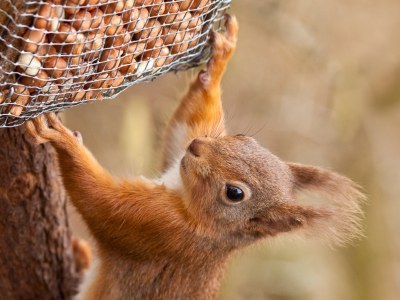
Many gardeners erect birdfeeders with the hopes of attracting and enjoying backyard birds. Before long, neighborhood squirrels discover them too, and move in to steal the seed. Keeping neighborhood squirrels out of your birdfeeder can seem like a losing battle. It doesn't have to be. All it takes is a little patience and some trial and error to see what works best.
To truly appreciate squirrels (and learn to live with them peacefully), it helps to know what drives their behavior-what makes squirrels do what they do. The squirrels you see raiding your birdfeeder are probably one or more of several common species of tree squirrels: Fox squirrels, Red squirrels, or Gray squirrels. These species are most active in morning and late afternoon. During mid day they usually retire to their nests or nap on nearby tree branches. Solitary by nature, tree squirrels don't hibernate in the winter, although they sometimes nest in small groups to stay warm. Here are a few interesting facts about squirrels:
Gardeners have found the following 3 tactics to be the most effective in discouraging squirrels from visiting birdfeeders. You may have to experiment with one or more before finding a solution that works for you.
Baffling them. If your birdfeeder hangs from a pole or is attached to a post, place a stove-pipe or pyramid-shaped baffle underneath the feeder to prevent squirrels from accessing the feeder from the ground. Purchase one, or make your own. To be effective, the bottom of the baffle needs to be at least 5 feet off the ground and 8 to 10 feet away from nearby objects. To prevent access from above, use a dome or umbrella-shaped baffle above your feeder. Make sure it's large enough to cover the feeder completely and that your feeder is least 8 to 10 feet away from buildings, branches and other objects the squirrels might climb.
Excluding them. Try enclosing your existing feeder in a wire mesh cage that has openings large enough for birds to get inside, but are small enough to exclude squirrels. Another option is to buy a "squirrel proof" feeder. Some feature weight activated trap doors that close off access to feeding holes whenever any animal as heavy as a squirrel steps on the perches.
Changing seeds. Squirrels raiding birdfeeders favor nuts, sunflower seeds, and cracked corn. One way to eliminate their visits is to offer seeds that are less appealing. For example, safflower seed attracts cardinals, chickadees, titmice, nuthatches, and grosbeaks. Squirrels (and other feeders hogs like grackles and starlings) don't care for them. Nyjer seed (also called thistle seed) is a favorite of goldfinches, purple finches, pine siskins, and even mourning doves, but squirrels won't bother with it.
At times squirrels can seem like a nuisance, but like backyard birds, they are really just going about the business of survival. There are many strategies for keeping them out of your birdfeeder, but the following methods are NOT recommended as they are either considered unnecessarily harmful (for squirrels and birds) or they just plain don't work.
Many people find the antics of squirrels very amusing and actually enjoy feeding them. After all, watching squirrels clown around in an effort to secure food can be an interesting and entertaining way to learn about nature. One way to keep them distracted from your birdfeeders is to provide them with their own feeding station. From "picnic tables" that hold corn cobs to feeders that bounce up and down on cables, there are countless squirrel feeders designed with your amusement in mind.

About The Author: Ellen Brown is an environmental writer and photographer and the owner of Sustainable Media, an environmental media company that specializes in helping businesses and organizations promote eco-friendly products and services.
Add your voice! Click below to comment. ThriftyFun is powered by your wisdom!
We hang our bird feeder between two large trees. The heavy duty wire is about 18 to 20 feet long and high enough off the round so that most squirrels can't jump to it. It's a basket feeder and the lid flips off to fill it. In 5 years only one squirrel has managed to jump on to feed, and we're not too sure how this happened. However with all the snow we've had this season we did have to keep it cleared under the feeder, or else we'd have had a few more chowing down. We find there is always some seed on the ground, and they do eat suet so they are pretty well fed. Good luck....
Great tips. I have a bird feeder that will shut its opening when an animal bigger than a bird sits on it. Works great, but it ends up breaking each year from all the squirrels that try to get in. Oh well.
I adore feeding and watering animals of all kinds! cracked corn and peanuts etc are great for squirrels; and yes, I feed birds, and raccoons, and cats, etc! love them all!
Add your voice! Click below to comment. ThriftyFun is powered by your wisdom!